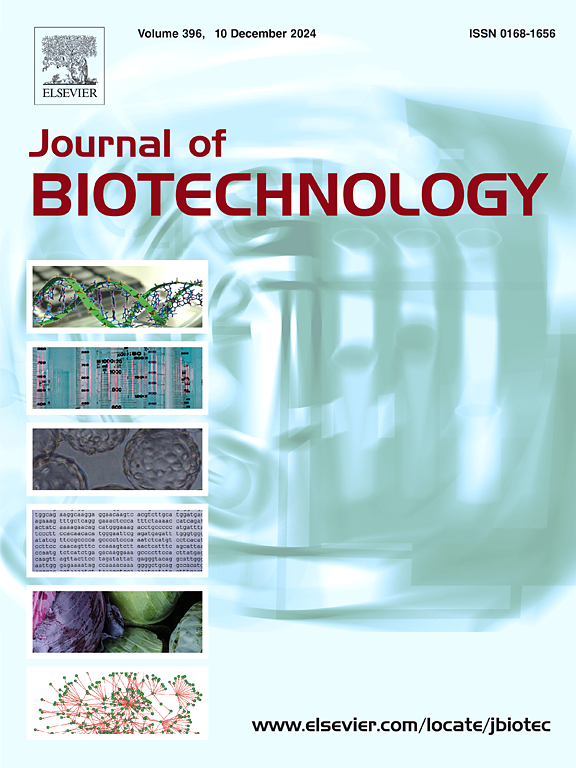优化木质纤维素转化:碱辅助球磨预处理棉秆和玉米秸秆的比较研究
IF 3.9
2区 生物学
Q2 BIOTECHNOLOGY & APPLIED MICROBIOLOGY
引用次数: 0
摘要
采用固体碱(NaOH或Ca(OH)2)辅助球磨(BM)预处理棉花秸秆(CTS)和玉米秸秆(CRS)。系统地考察了预处理材料的理化性质及其高固相酶解性能。BM过程中产生的机械力增强了碱与秸秆之间的相互作用,实现了木质素的有效脱除。在相同剂量下,NaOH对两种秸秆的脱木质素效率均优于Ca(OH)2。阳离子交换容量分析显示CTS- ca2 +复合物的稳定性高于CRS- ca2 +复合物,这解释了Ca(OH)2对CTS脱除木质素的效果优于CRS。在碱/BM过程中,纤维素表现出结构膨胀和结晶破坏。CTS的纤维素主要保持了纤维素I的结晶度,而CRS的纤维素大部分转化为无定形。这些理化性质和结构的变化有效地提高了预处理秸秆的酶解糖化效率。在高固载(20 %)条件下,naoh预处理和Ca(OH)2预处理的CTS的最大葡萄糖产率分别为68.52 %和65.90 %。CRS的产率分别为80.43 %和80.30 %。偏最小二乘(PLS)分析发现,秸秆组成,尤其是纤维素的变化,是影响酶解效率的主要因素。该研究为优化生物质特异性预处理策略以实现高效糖生产提供了有价值的见解。本文章由计算机程序翻译,如有差异,请以英文原文为准。
Optimizing lignocellulose conversion: A comparative study of alkali-assisted ball milling pretreatment of cotton stalk and corn stover
Cotton stalk (CTS) and corn stover (CRS) were pretreated using solid alkali (NaOH or Ca(OH)2) assisted ball milling (BM). The physicochemical properties of the pretreated materials and their high-solid enzymatic hydrolysis performance were systematically investigated. The interaction between alkali and straw was synergistically enhanced by mechanical force generated during BM, achieving effective lignin removal. NaOH showed superior delignification efficiency compared to Ca(OH)2 for both straws at same dosages. Analysis of cation exchange capacity revealed higher stability of CTS-Ca2+ complex than CRS-Ca2+ complex, explaining the more effective lignin removal from CTS than from CRS by Ca(OH)2. During the alkali/BM process, cellulose showed structural swelling and crystalline destruction. The cellulose of CTS mainly retained its cellulose I crystallinity, whereas most of the cellulose of CRS was converted to an amorphous state. The changes in physicochemical properties and structure effectively improved the enzymatic saccharification efficiency of pretreated straws. Under high-solids loading conditions (20 %) with an enzyme loading of 20 FPU/g, the maximum glucose yields from NaOH-pretreated and Ca(OH)2-pretreated CTS were 68.52 % and 65.90 %, respectively. The corresponding yields for CRS were 80.43 % and 80.30 %. Partial least squares (PLS) analysis identified straw composition, particularly changes in cellulose, as the dominant factor influencing enzymatic hydrolysis efficiency. This study provided valuable insights for optimizing biomass-specific pretreatment strategies to achieve efficient sugar production.
求助全文
通过发布文献求助,成功后即可免费获取论文全文。
去求助
来源期刊

Journal of biotechnology
工程技术-生物工程与应用微生物
CiteScore
8.90
自引率
2.40%
发文量
190
审稿时长
45 days
期刊介绍:
The Journal of Biotechnology has an open access mirror journal, the Journal of Biotechnology: X, sharing the same aims and scope, editorial team, submission system and rigorous peer review.
The Journal provides a medium for the rapid publication of both full-length articles and short communications on novel and innovative aspects of biotechnology. The Journal will accept papers ranging from genetic or molecular biological positions to those covering biochemical, chemical or bioprocess engineering aspects as well as computer application of new software concepts, provided that in each case the material is directly relevant to biotechnological systems. Papers presenting information of a multidisciplinary nature that would not be suitable for publication in a journal devoted to a single discipline, are particularly welcome.
 求助内容:
求助内容: 应助结果提醒方式:
应助结果提醒方式:


